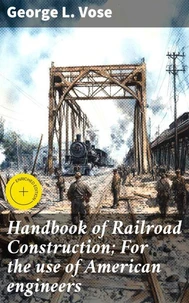Handbook of Railroad Construction; For the use of American engineers
Par :Formats :
Disponible dans votre compte client Decitre ou Furet du Nord dès validation de votre commande. Le format ePub est :
- Compatible avec une lecture sur My Vivlio (smartphone, tablette, ordinateur)
- Compatible avec une lecture sur liseuses Vivlio
- Pour les liseuses autres que Vivlio, vous devez utiliser le logiciel Adobe Digital Edition. Non compatible avec la lecture sur les liseuses Kindle, Remarkable et Sony
 , qui est-ce ?
, qui est-ce ?Notre partenaire de plateforme de lecture numérique où vous retrouverez l'ensemble de vos ebooks gratuitement
Pour en savoir plus sur nos ebooks, consultez notre aide en ligne ici
- Nombre de pages374
- FormatePub
- ISBN859-65--4721596-7
- EAN8596547215967
- Date de parution04/09/2022
- Protection num.Digital Watermarking
- Taille7 Mo
- Infos supplémentairesepub
- ÉditeurDIGICAT
Résumé
In "Handbook of Railroad Construction; For the Use of American Engineers, " George L. Vose meticulously details the technical and practical aspects of railroad engineering during a transformative period in American infrastructure development. This authoritative text is characterized by its clear, didactic prose and comprehensive content, accompanying numerous diagrams and illustrations that effectively convey complex engineering principles.
Vose's work serves as both a reference and a manual, addressing topics ranging from surveying and grading to track laying, thereby placing the reader firmly within the burgeoning context of 19th-century American industrial innovation. George L. Vose, a prominent figure in the field of civil engineering, utilized his extensive experience working on various railway projects across the United States to author this handbook.
His firsthand understanding of the challenges and intricacies of railroad construction drives the depth of knowledge contained within the text. Vose's educational background and professional career reflect a commitment to advancing engineering practices, which is vividly evident in his careful elucidation of methods tailored for American engineers of his time. I highly recommend "Handbook of Railroad Construction" not only for engineers and students in the field but also for historians interested in the pivotal role of railroads in shaping the American landscape.
Vose's insights into the practicalities of construction remain relevant, providing valuable lessons for contemporary engineers while preserving a crucial piece of America's engineering heritage.
Vose's work serves as both a reference and a manual, addressing topics ranging from surveying and grading to track laying, thereby placing the reader firmly within the burgeoning context of 19th-century American industrial innovation. George L. Vose, a prominent figure in the field of civil engineering, utilized his extensive experience working on various railway projects across the United States to author this handbook.
His firsthand understanding of the challenges and intricacies of railroad construction drives the depth of knowledge contained within the text. Vose's educational background and professional career reflect a commitment to advancing engineering practices, which is vividly evident in his careful elucidation of methods tailored for American engineers of his time. I highly recommend "Handbook of Railroad Construction" not only for engineers and students in the field but also for historians interested in the pivotal role of railroads in shaping the American landscape.
Vose's insights into the practicalities of construction remain relevant, providing valuable lessons for contemporary engineers while preserving a crucial piece of America's engineering heritage.
In "Handbook of Railroad Construction; For the Use of American Engineers, " George L. Vose meticulously details the technical and practical aspects of railroad engineering during a transformative period in American infrastructure development. This authoritative text is characterized by its clear, didactic prose and comprehensive content, accompanying numerous diagrams and illustrations that effectively convey complex engineering principles.
Vose's work serves as both a reference and a manual, addressing topics ranging from surveying and grading to track laying, thereby placing the reader firmly within the burgeoning context of 19th-century American industrial innovation. George L. Vose, a prominent figure in the field of civil engineering, utilized his extensive experience working on various railway projects across the United States to author this handbook.
His firsthand understanding of the challenges and intricacies of railroad construction drives the depth of knowledge contained within the text. Vose's educational background and professional career reflect a commitment to advancing engineering practices, which is vividly evident in his careful elucidation of methods tailored for American engineers of his time. I highly recommend "Handbook of Railroad Construction" not only for engineers and students in the field but also for historians interested in the pivotal role of railroads in shaping the American landscape.
Vose's insights into the practicalities of construction remain relevant, providing valuable lessons for contemporary engineers while preserving a crucial piece of America's engineering heritage.
Vose's work serves as both a reference and a manual, addressing topics ranging from surveying and grading to track laying, thereby placing the reader firmly within the burgeoning context of 19th-century American industrial innovation. George L. Vose, a prominent figure in the field of civil engineering, utilized his extensive experience working on various railway projects across the United States to author this handbook.
His firsthand understanding of the challenges and intricacies of railroad construction drives the depth of knowledge contained within the text. Vose's educational background and professional career reflect a commitment to advancing engineering practices, which is vividly evident in his careful elucidation of methods tailored for American engineers of his time. I highly recommend "Handbook of Railroad Construction" not only for engineers and students in the field but also for historians interested in the pivotal role of railroads in shaping the American landscape.
Vose's insights into the practicalities of construction remain relevant, providing valuable lessons for contemporary engineers while preserving a crucial piece of America's engineering heritage.



